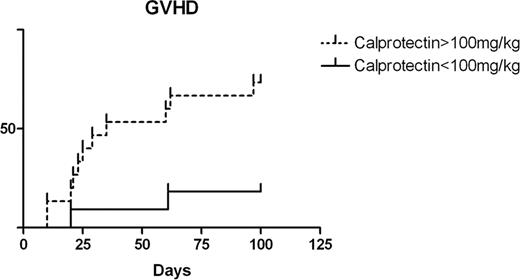Abstract
Abstract 1253
Graft-versus-host disease is one of the main complications after allogeneic stem cell transplantation. Recently, some authors focused their attention on the evaluation of proteomic pattern of biologic samples, as saliva and urine, in patients affected by GHVD. The aim of these studies was to identify a highly sensitive and specific marker of GVHD activity, with a predictive and prognostic value.
Several authors have investigated the role of fecal calprotectin in patients affected by inflammatory bowel disease. So, level of fecal calprotectin seems to have a proportional correlation to the degree of immune inflammation of the intestinal mucosa.
In this respect, we have analyzed the level of fecal calprotectin in patients submitted to allogeneic stem cell transplantation, to find a non invasive and rapid marker of GVHD.
We enrolled 32 patients affected by onco-hematological disease and submitted consecutively to allogeneic stem cell transplantation between February 2009 and April 2010 in our centre.
Patients’ characteristics were: M/F 18/14 with a median age of 49 years (range 17–65); diagnosis were MDS in 6 patients, plasmacellular leukemia in 1 patient, ALL in 2 patients, CLL in 1 patient, AML in 15 patients, NHL in 6 patients, myelofibrosis in 1 patient; 11 patients were in CR, 3 patients in relapse, 3 patients in PD, 3 patients in PR, 6 patients in stable disease and 6 patients have a refractory/resistant disease; a myeloablative conditioning regimen was used in 9 patient while the other 23 patients received a reduced intensity conditioning regimen; 16 patients received a graft from a match-unrelated donor and 16 from a sibling donor; stem cell source were BM in 1 patient, CB in 1 patient and PBSC in 30 pts; 3 pts received GVHD prophylaxis with CSA, 16 with CSA+MMF and 13 with CSA+MTX; 5 patient received also ATG and 2 Campath-H1. We evaluated the level of fecal calprotectin at day +30, +60 and +90 after transplant and at the onset of GVHD.
Median time to neutrophil engraftment (PMN>0.5×109/L) was 16 days after stem cell transplantation (range 10–29), while a spontaneous platelet recovery (PLTS>20×109/L) was achieved after a median time of 11 days (range 2–46). One pt did not achieve PLT engraftment for progressive disease. TRM at 100 days 25%: 2 pts died for aGVHD, 2 pts for sepsis, 1 pt for pulmonary aspergillosis and 3 for progression of disease. Fourteen pts developed aGVHD (4 pts grade I-II and 10 pts grade III-IV) and 12 pts developed cGVHD (3 pts limited and 9 pts extensive).
Fecal calprotectin median level in the first 100 days after transplantation was significantly higher in the group with aGVHD (median value 226.5mg/kg vs 62mg/kg, Fisher exact's test p=0.0063, RR 2.786, CI 1.199–6.473) and in the group of patients with cGVHD (median value 208mg/kg vs 62mg/kg, Fisher exact's test p= 0.0154, RR 2.708, CI 1.153–6.362). Considering the threshold of 100mg/kg we divided patients in 2 groups (< and > 100mg/kg) and we found a strong correlation between fecal calprotectin level and aGVHD onset (p=0.0076)(see figure 1).
Despite the small number of patients in our casistic we propose the determination of fecal calprotectin level as a marker of GVHD activity and as a possible predictive factor of cGVHD onset.
No relevant conflicts of interest to declare.
Author notes
Asterisk with author names denotes non-ASH members.


This feature is available to Subscribers Only
Sign In or Create an Account Close Modal